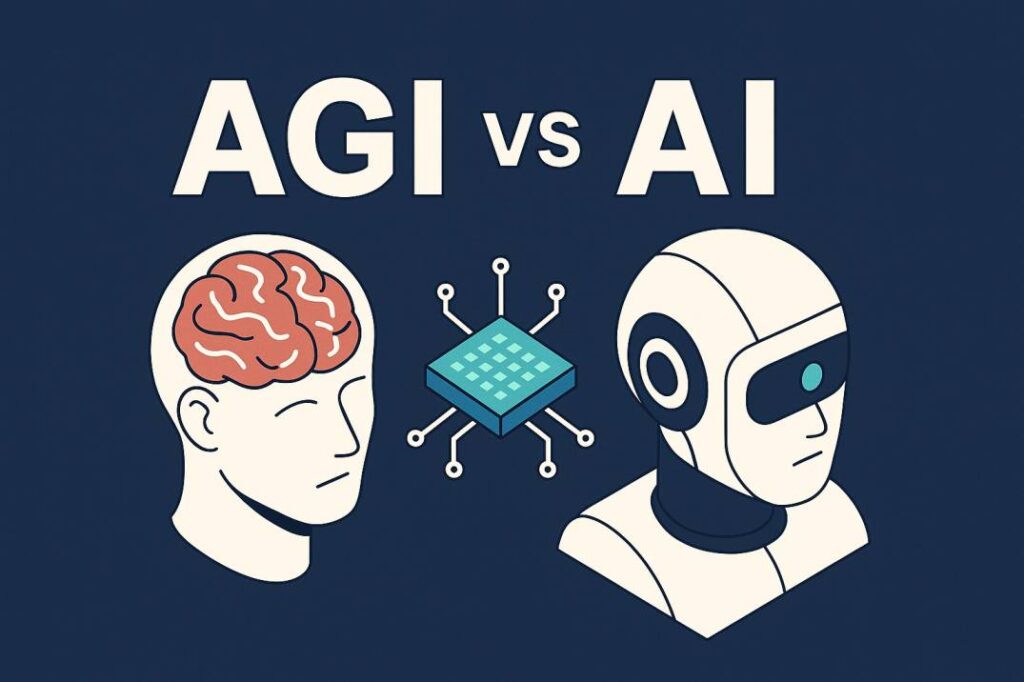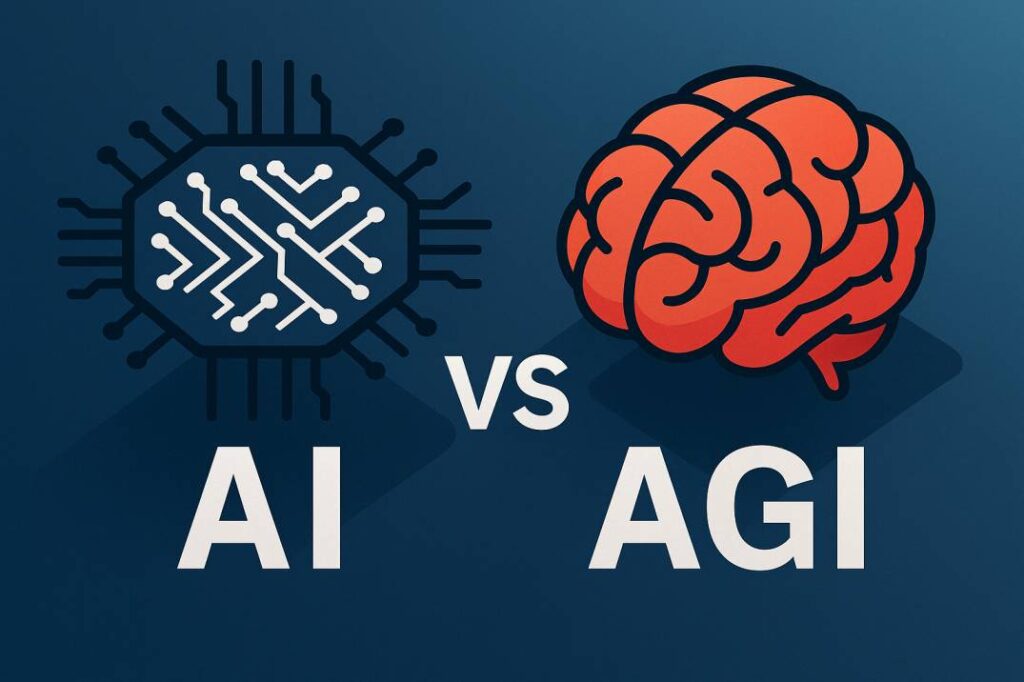In today’s fast-paced tech landscape, the conversation around Artificial General Intelligence (AGI) versus traditional AI is evolving rapidly. If you’ve ever wondered whether our smart tools are merely sophisticated assistants or precursors to truly intelligent machines, you’re not alone. This post unpacks the critical differences between AGI and AI, explores their implications, and provides a balanced view of what the future might hold.
Introduction: The Dawn of a New Intelligence
Imagine a world where machines don’t just execute programmed tasks but can think, learn, and reason much like humans. This isn’t science fiction—it’s the future that Artificial General Intelligence promises. Unlike today’s AI systems that are designed for specific tasks, AGI aims to replicate the comprehensive intellectual abilities of a human mind.
In this post, we dive deep into the leap from smart tools to smart minds, examining what distinguishes AGI from conventional AI and why this evolution is not only fascinating but also vital for our technological future. Whether you’re a tech enthusiast or a professional in the field, understanding this difference is key to anticipating the changes that lie ahead.

What Is AI? A Snapshot of Today’s Smart Tools
Before delving into AGI, it’s essential to understand what AI is today. AI, or artificial intelligence, refers to systems or machines that mimic human intelligence to perform tasks and can iteratively improve themselves based on the data they collect. Here are some core characteristics of current AI:
- Narrow Focus: Most AI systems are designed to perform a single task. For example, voice assistants like Siri or Google Assistant operate within a confined scope.
- Data-Driven: They rely heavily on data and algorithms to learn and make decisions.
- Task-Specific Optimization: Whether it’s recognizing speech, translating languages, or recommending products, these AIs excel in their narrow fields.
Key AI Applications Today
- Natural Language Processing (NLP): Used in chatbots and virtual assistants.
- Computer Vision: Powers facial recognition and autonomous vehicles.
- Predictive Analytics: Integral to recommendation engines on platforms like Netflix and Amazon.
Although AI has made tremendous strides in transforming industries, its intelligence is limited to specific domains—this is where AGI comes into the picture.
Defining Artificial General Intelligence (AGI)
Artificial General Intelligence represents the next leap—a machine that can understand, learn, and apply knowledge across a wide range of tasks as well as a human can. Unlike narrow AI, AGI aims for:
- Versatility: AGI can perform any intellectual task that a human being can.
- Autonomous Learning: It doesn’t rely solely on pre-fed data but can learn from new experiences autonomously.
- Human-like Reasoning: The goal is to have machines that not only process information but also reason, plan, and solve problems in an abstract way.
Characteristics of AGI
- Flexibility: Capable of transferring learning from one domain to another.
- Adaptability: Can operate in environments that are not pre-programmed or entirely predictable.
- Creativity: Possesses the ability to create, innovate, and perhaps even experience emotions in a limited context.
In essence, AGI is about building systems that go beyond performing set tasks—they aim to understand context and make decisions in real time, mirroring human cognitive functions.
The Comparison: Narrow AI vs. AGI
Let’s explore the key differences between current AI and the envisioned AGI. The following table provides a quick comparison:
| Feature | Narrow AI | Artificial General Intelligence (AGI) |
|---|---|---|
| Scope | Task-specific | Multi-domain, human-like versatility |
| Learning Ability | Pre-trained and data-dependent | Autonomous, self-improving through experience |
| Adaptability | Limited to defined scenarios | Capable of learning and adapting in unknown contexts |
| Reasoning | Follows set algorithms | Possesses abstract reasoning and creative problem-solving |
| Examples | Voice assistants, recommendation systems | Future intelligent systems mimicking human cognition |
While narrow AI has already changed the way we live and work, AGI represents a fundamental shift in our approach to technology.
Exploring the Implications of AGI
1. Economic Transformation
AGI has the potential to revolutionize industries:
- Automation 2.0: Beyond automating routine tasks, AGI could handle complex decision-making processes, affecting sectors like healthcare, finance, and manufacturing.
- Job Market Shifts: While many fear job displacement, AGI could also create new industries and roles focused on managing and enhancing AGI systems.
For a more detailed look at automation’s future, check out McKinsey’s insights on AI and automation.
2. Ethical and Social Considerations
With greater power comes greater responsibility:
- Bias and Fairness: Even today, AI systems face challenges with bias. With AGI, the stakes are even higher.
- Privacy Concerns: AGI systems could process vast amounts of personal data, raising significant privacy issues.
- Autonomy and Control: How much autonomy should we grant machines? This question becomes critical as AGI blurs the line between tool and independent decision-maker.
Experts from organizations like The Future of Life Institute discuss these ethical challenges extensively. It’s crucial to consider these aspects early in the AGI development process.
3. Technological and Scientific Advancements
AGI is expected to accelerate scientific discoveries:
- Research and Development: AGI could analyze complex datasets in seconds, potentially revolutionizing fields like drug discovery and climate science.
- Interdisciplinary Innovation: By synthesizing knowledge from different fields, AGI could spark innovations that we can’t yet imagine.
Personal Insights and Experiences
Working in the tech industry for over a decade, I’ve witnessed the evolution from simple automation to more complex AI-driven solutions. My personal journey has taught me that while AI can be an incredibly powerful tool, it’s the pursuit of AGI that truly excites the imagination.
I recall a project where our team used AI to optimize customer service. The AI was brilliant at handling routine queries, yet when it came to unexpected issues, the limitations of narrow AI became clear. This experience highlighted the need for a more adaptive, intelligent system—one that could truly understand context and nuance. The potential of AGI in such scenarios is enormous: imagine a customer service agent that not only resolves queries but anticipates customer needs in real time.
The Road Ahead: Challenges and Future Directions
Technical Challenges
Developing AGI is no small feat. Some of the technical hurdles include:
- Computational Power: AGI will require unprecedented levels of computing power and energy efficiency.
- Algorithmic Complexity: Building algorithms that can generalize learning across multiple domains is a formidable challenge.
- Safety and Control: Ensuring that AGI systems act safely and predictably is crucial. Initiatives like OpenAI’s safety research are making strides in this area.
Social and Regulatory Hurdles
Beyond technical issues, societal challenges loom large:
- Regulatory Frameworks: Governments will need to create laws and regulations that keep pace with technological advancements.
- Public Perception: There’s a fine line between optimism and fear when it comes to AGI. Transparent communication and education are key to managing public expectations.
- Global Cooperation: AGI development is a global effort. International collaboration will be essential to navigate the ethical, legal, and economic implications.
Opportunities for Innovation
Despite these challenges, the potential benefits are too significant to ignore:
- Enhanced Problem Solving: AGI could help solve some of humanity’s biggest challenges—from climate change to healthcare.
- New Business Models: The emergence of AGI could lead to entirely new industries and economic models, fostering growth and innovation.
- Improved Quality of Life: Ultimately, AGI aims to enhance human capabilities and improve our daily lives by handling complex tasks that currently require human intervention.
What Does the Future Hold?
While true AGI remains a long-term goal, incremental advances in AI are paving the way. The journey from smart tools to smart minds is marked by continuous learning, innovation, and adaptation. As we move forward, it’s important to balance ambition with caution, ensuring that the development of AGI benefits society as a whole.
Expert Opinions on AGI
Leaders in the field, such as Elon Musk and Stephen Hawking, have shared both excitement and caution regarding AGI. Their insights remind us that while the potential is immense, we must tread carefully. It’s a reminder that technological advancement and ethical responsibility must go hand in hand.
A Personal Take
From my perspective, the transition from AI to AGI is not just a technological upgrade—it’s a paradigm shift. It challenges us to rethink our relationship with technology and redefine what it means to be intelligent. As we develop smarter systems, the conversation around ethics, control, and the role of human creativity becomes more critical. In this context, AGI isn’t just about making machines smarter; it’s about augmenting human potential and creating a more interconnected future.
Visualizing the AGI Transition
A Quick Comparison Table
Below is a simplified table to help visualize the differences and overlaps between narrow AI and AGI:
| Aspect | Narrow AI | Artificial General Intelligence |
|---|---|---|
| Scope | Specific tasks (e.g., voice recognition) | Broad, human-like reasoning |
| Learning | Data-driven, limited to training sets | Autonomous learning and adaptation |
| Flexibility | Low—designed for particular functions | High—transferable knowledge across multiple domains |
| Reasoning | Algorithm-based, limited abstraction | Advanced, human-like abstract reasoning |
| Impact | Improves efficiency in specific areas | Potential to revolutionize entire industries |
Visual elements like this table can break up dense information, making it easier to digest complex ideas.
Bridging the Gap: How to Prepare for AGI
If you’re a business leader or tech enthusiast, here are some steps you can take to prepare for the AGI revolution:
- Stay Informed: Follow reputable sources like MIT Technology Review or Wired to keep up with the latest developments.
- Invest in Learning: Enhance your understanding of both AI and emerging AGI trends through online courses, webinars, and industry conferences.
- Experiment with AI Tools: Begin experimenting with current AI technologies to understand their limitations and strengths. Platforms like TensorFlow and PyTorch are great starting points.
- Network with Experts: Join communities and forums dedicated to AI and AGI to exchange ideas, ask questions, and share insights.
Conclusion: Embracing the Future of Intelligence
The leap from smart tools to smart minds is more than a technological evolution—it’s a journey toward a future where machines and humans work symbiotically. Artificial General Intelligence promises to redefine what technology can do, pushing the boundaries of innovation and opening doors to possibilities we’ve yet to imagine.
While there are significant challenges ahead—technical, ethical, and regulatory—the potential rewards are equally immense. By understanding the differences between narrow AI and AGI, we can better prepare for a future where technology not only supports our daily lives but also empowers us to reach new heights.
As we navigate this exciting frontier, one thing remains clear: the journey is just beginning. Whether you’re a developer, business leader, or curious reader, staying informed and engaged will be key to harnessing the true power of intelligence in all its forms.

If you found this deep dive into AGI vs. AI insightful, don’t forget to share your thoughts in the comments below! For more in-depth articles on tech trends and future innovations, subscribe to our newsletter and join our community at Lilosdata. Let’s explore the future of intelligence together!
References and further reading:


